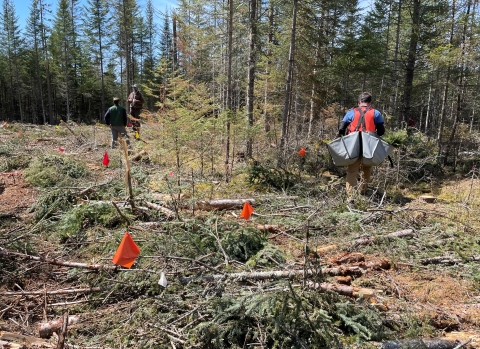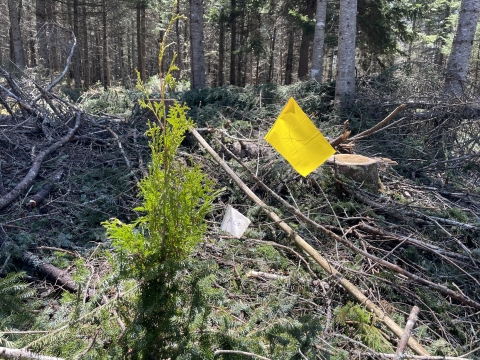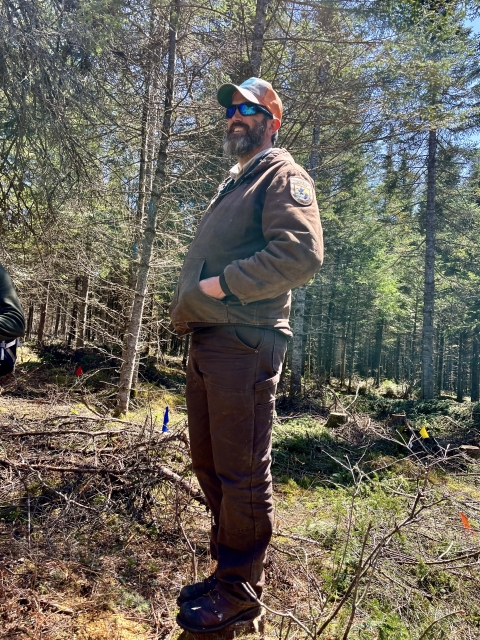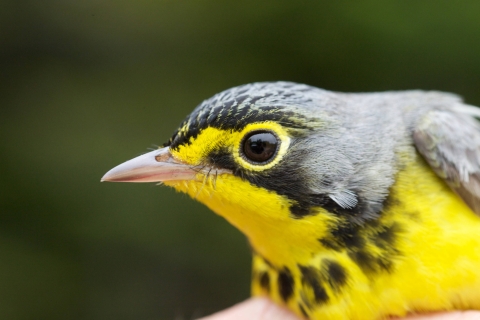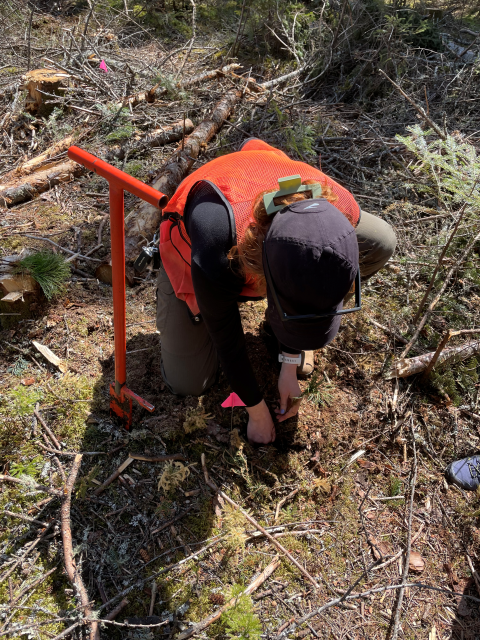“Take a look around: fir, fir, fir, fir, it’s almost 100 percent balsam fir,” said Jeremy Goetz, forester for the Silvio O. Conte National Fish and Wildlife Refuge, taking stock of our surroundings on an early-May morning in northeastern Vermont. “That’s a problem.”
Not only were the trees around us mostly the same species, but they were also mostly the same age, size, and height, creating a uniform canopy overhead. As Goetz indicated, from a forest-health perspective, there’s something wrong with this picture.
“Every tree species has different tolerances for temperature, moisture, diseases, and pests,” explained Tony D’Amato, director of the University of Vermont's forestry program, who joined us at the refuge. “That means a homogeneous forest — where everything is the same — is more vulnerable to natural disturbances and climate change climate change
Climate change includes both global warming driven by human-induced emissions of greenhouse gases and the resulting large-scale shifts in weather patterns. Though there have been previous periods of climatic change, since the mid-20th century humans have had an unprecedented impact on Earth's climate system and caused change on a global scale.
Learn more about climate change .”
It's common to see that type of forest in the nearly 27,000-acre Nulhegan Basin Division, which was harvested for timber for more than a century before it was acquired by the federal government in the 1990s. Red spruce, a once-abundant native species, was favored by loggers, and balsam fir filled in the void they left behind. While balsam fir is native to the region’s characteristic spruce-fir forests, its relative abundance has increased as a result of past management.
Now working with D’Amato, the refuge is trying to bring other native tree species back to the Nulhegan Basin as a strategy for improving forest health and wildlife habitat in the face of climate change.
“If we want forests to continue to provide the services we value, like habitat and carbon sequestration, we need to manage them with changing conditions in mind,” D’Amato said. “One way to do that is by increasing diversity, so when there’s a storm, a drought, or an outbreak of invasive species invasive species
An invasive species is any plant or animal that has spread or been introduced into a new area where they are, or could, cause harm to the environment, economy, or human, animal, or plant health. Their unwelcome presence can destroy ecosystems and cost millions of dollars.
Learn more about invasive species , the forest can recover.”
More than just adding tree species, that means diversifying the overall structure structure
Something temporarily or permanently constructed, built, or placed; and constructed of natural or manufactured parts including, but not limited to, a building, shed, cabin, porch, bridge, walkway, stair steps, sign, landing, platform, dock, rack, fence, telecommunication device, antennae, fish cleaning table, satellite dish/mount, or well head.
Learn more about structure of the forest. Instead of a uniform canopy overhead, you should see layers of vegetation, trees of different ages, and fallen trees left to rot and support habitat needs for a variety of wildlife.
“From an ecological standpoint, the forest should look a little messy, with a diversity of tree species and age classes,” explained refuge manager Steve Agius.
That’s why a stone’s throw away from the uniform balsam fir forest, there’s a 15-acre plot that looks dramatically different, by design. The forest floor is strewn with tree limbs; sunlight streams through new openings in the canopy; and hundreds of small, pink, blue, yellow, orange, and white flags dot the ground, heralding a future forest.
Common ground
That 15-acre plot is one of 34 treatment units within a 500-acre area of the refuge where the partners will be studying the forest’s long-term response to climate-change adaptation actions. The study is one of more than 100 climate-change adaptation demonstration projects underway throughout North America with support from the Northern Institute of Applied Climate Science.
"The goal of these projects is for land managers and scientists to come together to agree on goals, think through threats from a climate-change perspective, and identify on-the-ground actions that might increase the resilience of the forest to future changes,” D’Amato said.
In the Nulhegan Basin Division, restoring native species is at the top of the to-do list. Each colored flag on the forest floor indicated a different tree species to be planted. All are native to the region’s lowland spruce-fir forests — red spruce, white pine, northern white-cedar, and eastern hemlock — but scarce because of the legacy of logging.
“If you keep removing the same species of trees generation after generation, you limit the amount of seed source available to maintain a diverse forest,” explained Agius as we stumbled over branches in the study area. “Our goal is to take something that is structurally simple, like the area we just came from, and make it more structurally diverse.”
Setting the stage
In this case, the first step to increasing diversity wasn’t adding trees, it was removing them.
This winter, when the ground was frozen solid, the refuge oversaw removal of 330 acres of primarily balsam fir, using two different harvesting techniques: one that opened three-acre gaps in the forest with some tall overstory trees left behind, and another that left smaller, non-uniform gaps to support pockets of shrubby understory growth.
Both the how and where of the harvest reflect a research design that will produce measurable and transferable results.
Each of the harvesting techniques was replicated in 11 15-acre plots, while 12 other 15-acre plots were left unharvested as controls, for a total of 34 treatment units in the study.
The researchers assigned the three treatments randomly to those 34 units to eliminate bias in the selection process. In the 22 where harvesting occurred, they intentionally left behind branches and downed trees to provide structural diversity.
What became of the wood that was removed? Goetz, the refuge forester, arranged for the sale of the trees through a public bidding process, which was essential for the project to proceed. Since the refuge doesn't receive direct funding for forestry treatments, carrying out the research required finding a buyer for the wood.
Throughout April, a team from the University of Vermont placed 14,000 colored flags in the newly opened areas of forest to mark the spots where the trees would go. Each was positioned precisely following a design developed by research technician Grace Smith to provide statistically robust results during the monitoring phase of the project.
As soon as the ground thawed in May, they started planting.
Managing for the future
D’Amato and his team will track the success of the planted seedlings, evaluate changes in forest structure and species diversity in response to the treatments, and assess bird response to forest management — a priority for the refuge.
“There are a number of species of neo-tropical migratory birds that have a preference for spruce-fir forests,” Agius said. “Many of those species — including Canada warbler and rusty blackbird — are consistently showing declines in their populations.”
Developing adaptation strategies that support the refuge’s management objectives is central to the project, but there are broader implications for managing spruce-fir forests in general in the face of climate change.
“For a long time, we have managed forests based on past conditions, but it’s clear that we need new guidance to help us sustain the values forests provide into the future,” D’Amato said. “It’s apparent not only that climate change is coming, but that it’s already here.”
Forever forests
The weather was perfect for planting the day we visited the basin. It was sunny and in the high 60s, but because it had rained for two days prior, the ground was soft. Carrying shoulder bags full of conifer seedlings, a crew of graduate students and volunteers worked their way through the research plots, stopping at each flag to dig a hole and tuck a young tree into the earth.
The plan was to get 14,000 seedlings in the ground by the end of the month. That’s an ambitious rate of 450 trees a day, and the urgency of the task only increases with the passage of time. Seedlings planted later face greater risk of drying out. A few days after we visited, temperatures soared into the upper 80s — unseasonably warm weather for northern Vermont in May.
The work is repetitive, and slow-going because of the constant need to navigate through woody debris, but it’s also rewarding. Everyone knows they are contributing to something bigger.
Although Vermont — named for its conifer-covered mountains — is among the most-forested states in the U.S., D’Amato said, “We are losing forest in Vermont for the first time in a century due to development.”
At the end of the day, as the crew loaded the equipment and leftover seedlings into the bed of a pickup truck, Agius put their efforts into context.
“On behalf of future generations, I want to thank all of you for what you’re doing — it really is making a difference,” he said. “These lands will forever belong to the American public.”
We know the forests of the Nulhegan Basin Division will look different in 100 years. But thanks to this effort, it's possible that the future forests can continue to provide the same benefits to generations of people and wildlife to come.


